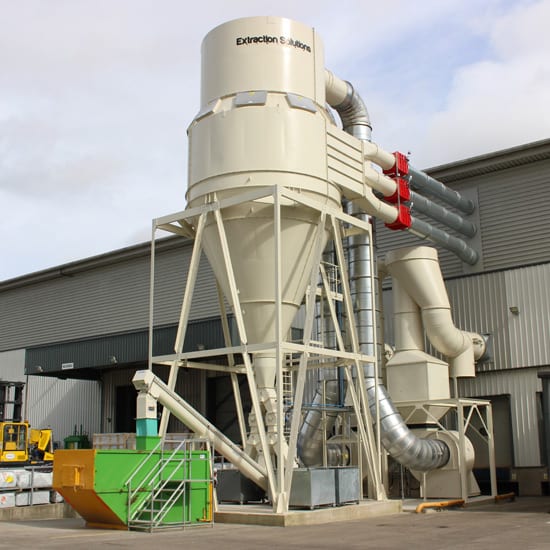EXPOSURE TO WOOD DUST
Harmful dusts and fibres are released when processing hardwoods, softwoods or MDF. These hazardous sawdust particles can cause serious health issues if not correctly controlled. Wood dust extraction systems from Extraction Solutions are designed to remove these particles at source before they come into contact with operators. It is important for employers to carry out risk assessments to ensure their employees are working in a safe and dust free environment.
ARE WOOD FUMES DANGEROUS?
Exposure to sawdust or other wood dust can cause various health complications ranging from skin conditions to asthma and even cancer. Therefore employers need to create a dust-free working environment. Wood dust is also flammable and can cause an explosion when confined and if the dispersion of dust particles are in the right concentration. To minimise this risk, use woodworking extraction to collect the dust. On top of this, large dust clouds can impair the vision of workers when operating dangerous machinery and can be a tripping hazard if it accumulates on the floor.
Why Is Controlling Wood Dust Necessary?
Wood dust falls under the control of substances hazardous to health (COSHH) regulations, and employers should carry out a risk assessment to identify hazards. Controls should be implemented so that the workplace exposure limit (WEL) does not exceed the maximum for hardwoods and softwoods of 5mg/m3.
Calculate an operator’s WEL on the average exposure during the work period. The WEL for hardwoods and softwoods is 5 mg/m3, based on the average dust content in the air over 8 hours. If the WEL exceeds the maximum 5mg/m3, improvements or additional control measures must be implemented, such as a sawdust extractor.
The workplace exposure limit (WEL) for hardwoods and softwoods is 5 mg/m3. This is based on the average dust content in the air over an 8 hour period. Tests can be carried out to calculate an operator’s WEL, and is based on average exposure during the work period. If the WEL exceeds the maximum 5mg/m3 then improvements or additional control measures must be put in place, such as a wood dust extraction system.


How To Control Dust Exposure
Local exhaust ventilation (LEV) extraction systems are the best way to control wood dust exposure. Correctly placed hoods remove the wood and sawdust at the source before it has the chance to reach the operators’ breathing space.
Your woodworking dust extractor should be designed to handle the correct airflow for each machine and be tested regularly to ensure that the capture at each point is effective. Extraction Solutions can create a bespoke wood extractor tailored to your specific needs.
It’s not always practical to have a local connection to a wood extraction system for every process. In these cases, undertake a risk assessment to find a solution – an example of this is could a large CNC bed.
Once a cycle is complete, there is often dust left in cuts or on the table. Instead of brushing this off, which can create a dust cloud, a standalone vacuum unit or Vac connection into the wood dust extraction systems could be used.
Extraction solutions can provide ideas and solutions to overcome any dust-related problem. Our engineers have seen it all with years of experience in the woodworking industry.
HOW TO ASSESS RISKS
When dealing with harmful substances a risk assessment should be completed. We have put together an example on how you can evaluate your processes.
#1 Identify the Risks
The first part of the risk assessment should be to identify the hazards so you can deal with them effectively#1 Identify the Risks
Look at the process and identify the potential hazards. What are the harmful dusts being emitted? Who is effected and how far reaching is the exposure?
#2 How Often is This Used
Frequency of use is important when determining how to tackle control#2 How Often is This Used
If an operator is working in an open area for an hour each week, RPE could be used. Long term operations should be controlled using more permanent measures.
#3 Change the Process
Are there safer materials or processes that could be used?#3 Change the Process
Try to identify if it’s possible to change the process to reduce exposure. Could a different material be used, or pre-cut/pre-finished materials, to reduce exposure?
#4 Which Controls Work
Determine if and what controls should be implemented to reduce the risk#4 Which Controls Work
Based on the information, what controls best suit your environment? Can extraction be added? If there are no suitable controls, RPE can be considered
#5 Consider PPE/RPE
This should be the last resort when identifying control measures#5 Consider PPE/RPE
If there are no other methods available to control the fume and the process can’t be changed, then PPE/RPE can be considered. A separate risk assessment should be undertaken
GET IN TOUCH WITH US
Fill in the form and we’ll get back to you!

